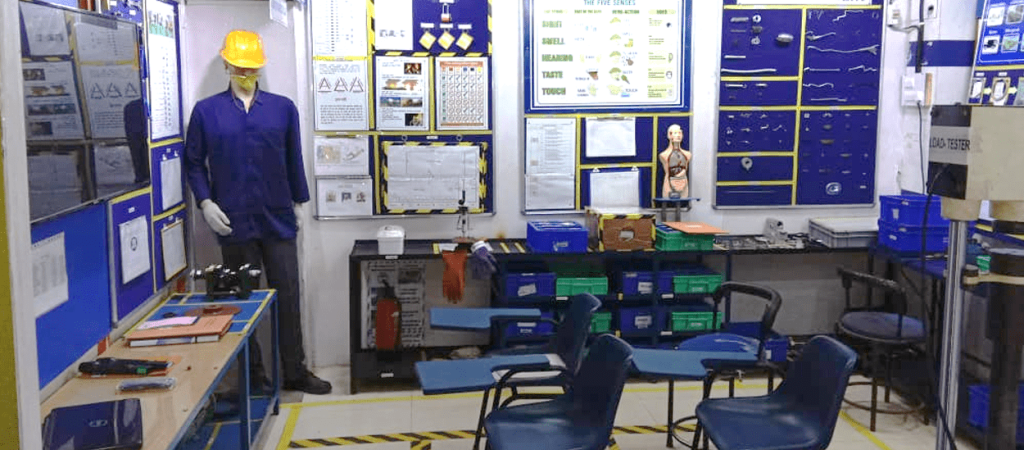DOJO Room (अखाडा )


“Tell me and I forget, teach me and I may remember, involve me and I learn.”– Benjamin Franklin
Introduction
In the marriage function, before going ahead with the mass production of food, a small portion of the food is prepared and tasted. Based on the response, further food is prepared. Something similar happens in the wineries too, wherein there are professional wine tasters whose job is to taste and approve the wine before mass production.
Read More: https://bit.ly/OnJobTrainingOJT
Objective
DOJO is a place to practice. This is a Japanese word meaning ‘let’s do it.’ The DOJO centre mainly focuses on imparting practical training, simulated training & game training for a specific process in manufacturing.
This article will cover what is DOJO Centre, the goal of the DOJO centre, why it important, who can provide the training, how to provide the training and the possible benefits. Once you read this blog, you will understand the advantages of DOJO Centre and how to implement it at your workplace successfully.
Read More: https://bit.ly/ROI-Training
Definition:
Competence (ISO 9000: 2015, Cl 3.10.4): Ability to apply knowledge and skills to achieve intended results
Skill (ISO 30401: 2018, Cl 3.30): Learned capacity to perform a task to a specified expectation
Knowledge (ISO 30401: 2018, Cl 3.25): Human or organizational asset enabling effective decisions and actions in the context
Read More: https://bit.ly/OrganizationKnowledge
Detailed Information
What is DOJO?
 DOJO means “a place of the way” in Japanese. Vernacularly speaking, DOJO is a place to train in martial arts such as Kendo, Judo, Aikido and so on. In a manufacturing context, a DOJO centre is a place for gaining the skill, understanding the organization’s shop floor environment and thoroughly preparing the team members, especially the fresh ones (operator and staff), before they take on their responsibility on the manufacturing shopfloors.
DOJO means “a place of the way” in Japanese. Vernacularly speaking, DOJO is a place to train in martial arts such as Kendo, Judo, Aikido and so on. In a manufacturing context, a DOJO centre is a place for gaining the skill, understanding the organization’s shop floor environment and thoroughly preparing the team members, especially the fresh ones (operator and staff), before they take on their responsibility on the manufacturing shopfloors.
 Read More: https://bit.ly/CompetencyRequirement
Read More: https://bit.ly/CompetencyRequirement
Goal of a DOJO Centre?
The primary goal behind DOJO is to benchmark quality efficiencies so that zero-defect products can be created and supplied to customers.
In a DOJO centre, a worker is trained again and again systematically in a particular task using replica models or mock-ups till he or she perfects the task. Safety culture is inculcated since the beginning. Experienced trainers, help the new operators gain confidence and correct them each time. An effort to replicate exact working conditions inside a shopfloor is also made so that the learner feels at ease when he joins work after his training. Ideally, a fresh worker is trained for 9-10 days before he joins the shop floor. An assessment test conducted at the end of the training helps measure the impact of training. Re-skilling of existing workforce helps in refreshing the manufacturing concepts and also in educating about new technological advancements. The DOJO centre also provides theory lessons in basic concepts of manufacturing apart from a brief overview of the company and its culture. Knowledge about the company helps the worker stay connected. The main thrust of the DOJO training remains on-job training sessions.
Read More: https://bit.ly/TraningNeedIdentification
Why is DOJO Centre Required?
After completing the qualification, when the personnel joins any organization (staff or operator), generally they have theoretical knowledge. Moreover, even if a person is joining with some industrial experience (Electronic Industry), it may not be relevant to that industry (Fabrication process). Also in case of job rotation, the DOJO centre helps the operator to learn a new skill.
 The main thrust of DOJO training remains OJT (on-job training) sessions. DOJO centre helps the employees to understand the nuances of that organization wrt to the manufacturing process. Moreover, with the fast-changing technology, it helps the employees to learn new skills (COBO: Collaborative Robots), the latest technologies (Industry 4.0: IoT, Artificial Intelligence), refresh their existing skills (tightening, assembling, material handling) and amend the existing wrong practices (5S).
The main thrust of DOJO training remains OJT (on-job training) sessions. DOJO centre helps the employees to understand the nuances of that organization wrt to the manufacturing process. Moreover, with the fast-changing technology, it helps the employees to learn new skills (COBO: Collaborative Robots), the latest technologies (Industry 4.0: IoT, Artificial Intelligence), refresh their existing skills (tightening, assembling, material handling) and amend the existing wrong practices (5S).
Read More: https://bit.ly/TrainerCompetency
Who Provides the DOJO training?
Qualified personnel of Production, Quality, Maintenance, Safety and Management Systems
How DOJO training is Provided (Examples):
In any organization, there may be a variety in which a new joiner should understand that they can gel with the company’s culture and way of working. There are 8 key aspects that can be covered in the DOJO centre.
- About Company: Organogram, roles, responsibility & authority, Policies
- Safety: What is Safety, Why safety is important, different aspects of safety like fire, how to follow safety practices, what to do in case of emergency, applicable legal Requirements
 5 Senses: Sight, Smell, Sound, Taste and Touch
5 Senses: Sight, Smell, Sound, Taste and Touch- Product: Type of product, Customers, subassemblies, impact on the end customer
- Manufacturing Process: Different production activities, Abnormality handling, how to read work instructions, 4M change, How to deal with NC, identification and traceability, process flow
- Product Quality: Customer requirement, Poison Test, Fitment, Function
- Machine Maintenance: Preventive, Predictive, Breakdown, Overhaul, CLIT
- Quality System: Quality Policy, Business Plan, Performance Indicators
Read More: https://bit.ly/CompetencyMapping1
Benefits of DOJO Centre:
- Create a muscle memory
- Develops safety culture
 Initiates the concept of error prevention
Initiates the concept of error prevention- Producing consistent quality
- Understanding about productivity
- Enhances employee morale
Read More: https://bit.ly/EmployeeSatisfaction1
Read More: https://bit.ly/Kirkpatrick4LevelModel
Industry Challenges:
- How often the organizations are serious about effectively implementing the training in the DOJO Room?
- How often the operators and staff are serious about understanding and learning during the training in the DOJO centre?
- How often there is a systematic mechanism to monitor the effectiveness of the DOJO training?
Read More: https://bit.ly/DifferenceCoachingMentoring
References:
ISO 9001: 2015
ISO 9002: 2016
ISO 9004: 2018
IATF 16949: 2016
Industry Experts
This is the 171st article of this Quality Management series. Every weekend, you will find useful information that will make your Management System journey Productive. Please share it with your colleagues too.
In the words of Albert Einstein, “The important thing is never to stop questioning.” I invite you to ask anything about the above subject. Questions and answers are the lifeblood of learning, and we are all learning. I will answer all questions to the best of my ability and promise to keep personal information confidential.
Your genuine feedback and response are extremely valuable. Please suggest topics for the coming weeks.

Beautifully explained in simple words. Thank you so much for your efforts to share your knowledge with the community.
Dear Neelabh, Thanks for your response and appreciation.